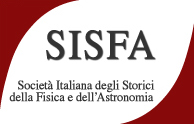Conveners
Twentieth Century Physics and Astronomy: Part 1
- Giancarlo Truffa (Member of SISFA)
Twentieth Century Physics and Astronomy: Part 2
- Roberto Lalli (Max Planck Institute for the History of Science)
La cartella contenente i fogli delle Memorie di Dilworth/Occhialini è conservata nell'Archivio Dilworth-Occhialini presso la Biblioteca BICF dell'Università degli Studi di Milano. Esse coprono i due periodi inglesi di Giuseppe Paolo Stanislao Occhialini (1907 - 1993): a Cambridge tra il 1931 e il 1934 e a Bristol tra il 1945 e il 1948.
Le Memorie sono state scritte tra un giorno imprecisato...
Contemporary physics developed in the twentieth century through a succession of revolutions that upset its epistemological status with the prospect of a new ontology and a new gnoseology. From the physics of chaos to the theories of relativity, from quantum physics to quantum-relativistic field theory and the theory of the S matrix ("scattering matrix"). Recently, the transversal scientific...
Models are of central importance in many scientific contexts and scientists spend significant amounts of time in building, testing, comparing, and revising models. The study of models and how they are used in scientific practice is a widely debated topic in the actual philosophy and history of science. A physical model is an abstract non-linguistic structure created from general principles –...
We will briefly review the amazing story of Luigi G. Jacchia (Trieste, 1910 - Cambridge MA, 1996), an Italian astronomer who started his career at the Bologna Observatory in 1928 and found then his new life in the US, since 1939 by escaping, as a Jewish, the WWII's tragedy in Europe. With Fred Whipple, along his Harvard/SAO years, Jacchia joined the pioneering group of scientists that led to...
During the summer of 1962, the new observatory of Tartu – today in Estonia, back then part of the USSR – was under construction, to be inaugurated the following year. Given its importance in the subsequent decades, as well as its (by now) bicentenary historical tradition, this alone would be a fact worth historical investigation. In July of that year, a sort of summer school (other sources...
Stanley Deser's multifaceted contributions to quantum gravity are here analyzed, starting from his contribution to the famous 1957 Chapel Hill conference on “The Role of Gravitation in Physics”. The main idea of his talk, as also summarized in Peter G. Bergmann's introduction, was the possibility offered by the development of quantum gravity to provide a way of imposing a cut-off to...
Although the common lore unofficially (and erroneously) credits Feynman with the famous quote “shut up and calculate!”, he did not avoid foundational questions in quantum mechanics. The first records of his considerations on such issues are in the report of the 1957 Chapel Hill conference on “The Role of Gravitation in Physics”, where foundational quantum issues were widely debated, especially...
This paper explores how, from the seventeenth century onwards, the armillary sphere was refigured and recontextualized into a Copernican mindset, while retaining its symbolic character as an emblem of astronomy, and its educational value as a model to demonstrate the essential celestial motions from a geocentric perspective. The modern history of the armillary sphere is addressed in its...

